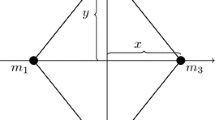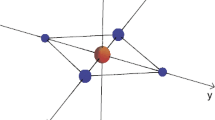Abstract
We consider a symmetric five-body problem with three unequal collinear masses on the axis of symmetry. The remaining two masses are symmetrically placed on both sides of the axis of symmetry. Regions of possible central configurations are derived for the four- and five-body problems. These regions are determined analytically and explored numerically. The equations of motion are regularized using Levi-Civita type transformations and then the phase space is investigated for chaotic and periodic orbits by means of Poincaré surface of sections.






















Similar content being viewed by others
References
Alvarez-Ramírez, M., Corbera, M., Llibre, J.: On the central configurations in the spatial 5-body problem with four equal masses. Celest. Mech. Dyn. Astron. 124, 433 (2016)
Bakker, L., Simmons, S.: Discrete Contin. Dyn. Syst. 35, 2 (2012)
Burgos-Garcia, J., Delgado, J.: Astrophys. Space Sci. 345, 247 (2013)
Cheb-Terrab, E.S., Oliveira, H.P.: Comput. Phys. Commun. 95(2–3), 171 (1996)
Chen, K.C.: Arch. Ration. Mech. Anal. 158, 293 (2001)
Corbera, M., Llibre, J.: J. Math. Phys. 47, 122701 (2006)
Corbera, M., Cors, J.M., Roberts, G.E.: arXiv:1610.08654 (2016)
Csillik, I.: Metode de Regularizare în Mecanica Cerească (Regularization Methods in Celestial Mechanics). Casa Cărţii de Ştiinţă, Cluj-Napoca (2003)
Delgado-Fernandez, J., Perez-Chavela, E.: The rhomboidal four-body problem. Global flow on the total collision manifold. In: The Geometry of Hamiltonian Systems, pp. 97–110. Springer, New York (1991)
Deng, C., Zhang, S.: J. Geom. Phys. 83, 43 (2014)
Diacu, F.: Lecture held at the Annual Session of the Astronomical Institute of Romanian Academy, 15–16 May 2003, Bucharest
Dziobek, O.: Astron. Nachr. 152, 32 (1900)
Gidea, M., Llibre, J.: Celest. Mech. Dyn. Astron. 106(1), 89 (2010)
Hampton, M.: Nonlinearity 18(5), 2299 (2005)
Hampton, M., Jensen, A.: Celest. Mech. Dyn. Astron. 109(4), 321 (2011)
Ji, J.H., Liao, X.H., Liu, L.: Chin. Astron. Astrophys. 24, 381 (2000)
Kulesza, M., Marchesin, M., Vidal, C.: J. Phys. A, Math. Theor. 44, 485204 (2011)
Lacomba, E.A., Perez-Chavela, E.: Celest. Mech. Dyn. Astron. 54, 343 (1992)
Lacomba, E.A., Perez-Chavela, E.: Celest. Mech. Dyn. Astron. 57, 411 (1993)
Lee, T.L., Santoprete, M.: Celest. Mech. Dyn. Astron. 104(4), 369 (2009)
Llibre, J.: Proc. Am. Math. Soc. 143, 3587 (2015)
Llibre, J., Mello, L.F.: Celest. Mech. Dyn. Astron. 100, 141 (2008)
Llibre, J., Moeckel, R., Simó, C.: Central Configurations. Springer, Basel (2015)
MacMillan, W.D., Bartky, W.: Trans. Am. Math. Soc. 34, 838 (1932); Dyn. Astron. 57, 411
Marchesin, M., Vidal, C.: Celest. Mech. Dyn. Astron. 115, 261 (2013)
Meyer, K.R., Hall, G.R.: Introduction to Hamiltonian Dynamical Systems and the \(n\)-Body Problem. Springer, New York (1992)
Mioc, V., Barbosu, M.: Serb. Astron. J. 167, 47 (2003)
Mioc, V., Blaga, C.: Hvar Obs. Bull. 23, 41 (1999)
Moeckel, R.: Scholarpedia 9(4), 10667 (2014)
Ollongren, A.: J. Symb. Comput. 6(1), 117 (1988)
Perez-Chavela, E., Santoprete, M.: Arch. Ration. Mech. Anal. 185, 481 (2007)
Roberts, G.E.: Physica D 127, 141 (1999)
Shoaib, M., Steves, B.A., Széll, A.: New Astron. 13, 639 (2008)
Shoaib, M., Faye, I., Sivasankaran, A.: Some special solutions of the rhomboidal five-body problem. In: International Conference on Fundamental and Applied Sciences 2012 (ICFAS2012), vol. 1482, pp. 496–501. AIP, New York (2012)
Shoaib, M., Sivasankaran, A., Aziz, Y.A.: Chaotic Model. Simul. (CMSIM) 3(3), 431 (2013)
Shoaib, M., Kashif, A.R., Sivasankaran, A.: Adv. Astron. 2016, 9897681 (2016)
Simó, C.: Celest. Mech. 18, 165 (1978)
Szücs-Csillik, I.: Poster presented at the Symposium “Vistas in Astronomy, Astrophysics and Space Sciences” (2016)
Waldvogel, J.: Celest. Mech. Dyn. Astron. 113, 113 (2012)
Yan, D.: J. Math. Anal. Appl. 388, 942 (2012)
Acknowledgements
We thank the editor and the anonymous reviewer for their constructive comments, which helped us improve the presentation of the manuscript. We also thank Professor Mihail Barbosu for correcting and improving the language of the manuscript. I. Szücs-Csillik is partially supported by a grant of the Romanian Ministry of National Education and Scientific Research, RDI Programme for Space Technology and Advanced Research - STAR, project number 513, 118/14.11.2016.
Author information
Authors and Affiliations
Corresponding author
Appendix
Appendix
1.1 Derivation of \(R_{N_{\mu_{0}}}\)
The numerator of \(\mu_{0}\), \(N_{\mu_{0}}\) is positive when \({A}_{ {1}}{C}_{{2}}{C}_{{3}}>0\) and \({B}_{{1}}{B}_{{3}}{C}_{{2}}+{B}_{ {2}}{C}_{{1}}{C}_{{3}}<0\) or when both factors have opposite sign and the positive factor is greater than the absolute value of the negative factor. All these possibilities are listed below with the corresponding regions, where \(N_{\mu_{0}}>0\):
-
1.
\({A}_{{1}}{C}_{{2}}{C}_{{3}}>0\) and \({B}_{{1}}{B}_{{3}}{C}_{{2}}+ {B}_{{2}}{C}_{{1}}{C}_{{3}}<0\): Using numerical approximation techniques we see that \(N_{\mu_{0}}>0\) in the following region:
$$ R_{cN_{\mu_{0}}}(t,w)=R_{aN_{\mu_{0}}}(t,w)\cup R_{bN_{\mu_{0}}}(t,w), $$(56)where
$$\begin{aligned} R_{aN_{\mu_{0}}}(t,w) =&\bigl\{ (t,w)|(0< t< 0.41\wedge0< w< 1) \\ &{}\vee(0.41< t< 1\wedge w>2.41)\vee\bigl(-1.73 \\ &{}< w\leq-1.5\wedge0.75\cdot d_{2}(w)< t< 1\bigr)\bigr\} , \\ R_{bN_{\mu_{0}}}(t,w) =&(w< -1.8\wedge0< t< 0.23)\vee(-1.43 \\ &{}< w\leq-1\wedge0.56< t< 1)\vee(-1< w \\ &{}< -0.41\wedge0.41< t< -w)\vee(2< w \\ &{}< 2.41\wedge0.41< t< 1). \end{aligned}$$ -
2.
\({A}_{{1}}{C}_{{2}}{C}_{{3}}>0\) and \({B}_{{1}}{B}_{{3}}{C}_{{2}}+ {B}_{{2}}{C}_{{1}}{C}_{{3}}>0\). It is numerically confirmed that \({B}_{{1}}{B}_{{3}}{C}_{{2}}+{B}_{{2}}{C}_{{1}}{C}_{{3}}>{A}_{{1}} {C}_{{2}}{C}_{{3}}\) when \({A}_{{1}}{C}_{{2}}{C}_{{3}}>0\). Hence, \(N_{\mu_{0}}<0\) for all \((t,w)\) such that \({A}_{{1}}{C}_{{2}}{C}_{ {3}}>0\).
-
3.
\({A}_{{1}}{C}_{{2}}{C}_{{3}}<0\) and \({B}_{{1}}{B}_{{3}}{C}_{{2}}+ {B}_{{2}}{C}_{{1}}{C}_{{3}}<0\). In this case using numerical approximation techniques we find that \(N_{\mu_{0}}\) is positive in the following region:
$$\begin{aligned} R_{dN_{\mu_{0}}}(t,w) =&\bigl\{ (t,w)|(-1.73< w< -1.5 \\ &{}\wedge 0< t< 0.25)\vee\bigl(-1.5\leq w< -1 \\ &{}\wedge 0< t< 0.2\cdot d_{2}(w)\bigr)\vee(0< t< 0.41 \\ &{}\wedge -t< w < 0) \vee(0.41< t< 1 \\ &{}\wedge 0< w< 1)\bigr\} . \end{aligned}$$
Hence, \(N_{\mu_{0}}>0\) in (see Fig. 9b)
1.2 Derivation of \(R_{N_{\mu_{2}}}\)
The numerator of \(\mu_{2}\), \(N_{\mu_{2}}\), is always positive when \(A_{3}B_{2}C_{1} >0\) and \(A_{1}A_{3}C_{2}+A_{2}C_{1}C_{3}<0\). It is not necessarily positive when \(A_{3}B_{2}C_{1}>0\) and \(A_{1}A_{3}C_{2}+A _{2}C_{1}C_{3}<0\) or \(A_{3}B_{2}C_{1}<0\) and \(A_{1}A_{3}C_{2}+A_{2}C _{1}C_{3}<0\). It might be positive in a segment of this region or might not be positive at all. We will list all these possibilities below with the corresponding regions, where \(N_{\mu_{2}}>0\).
-
1.
\(A_{3}B_{2}C_{1}>0\) and \(A_{1}A_{3}C_{2}+A_{2}C_{1}B_{3}<0\). Using numerical approximation techniques we show that \(N_{\mu_{2}}>0\) in
$$\begin{aligned} R_{aN_{\mu_{2}}}(t,w) =&aaN_{\mu_{2}}(t,w)\cup baN_{\mu_{2}}(t,w) \\ &{}\cup caN _{\mu_{2}}(t,w), \end{aligned}$$(58)where
$$\begin{aligned} aaN_{\mu_{2}}(t,w) =&\bigl\{ (t,w)|\bigl(0< w\leq0.41\wedge d_{1}(w) \\ &{}< t< 1\bigr) \vee\bigl(0.41< w< 0.58 \\ &{}\wedge d_{1}(w)< t< 0.5\cdot d_{2}(w)\bigr) \\ &{}\vee\bigl(w>\sqrt{3}\wedge0< t< d_{1}(w)\bigr)\bigr\} , \\ baN_{\mu_{2}}(t,w) =&\bigl\{ (t,w)|(w\leq-2.41\wedge0.463 \\ &{}- 0.079\cdot w < t< 1)\vee\bigl(-2.41< w \\ &{}< -1.73\wedge0.463-0.079w \\ &{}< t < 0.5 d_{2}(w)\bigr)\bigr\} , \\ caN_{\mu_{2}}(t,w) =&\bigl\{ (t,w)|1< w< 1.73 \wedge 0< t< d_{1}(w)\bigr\} . \end{aligned}$$ -
2.
\(A_{3}B_{2}C_{1}>0\) and \(A_{1}A_{3}C_{2}+A_{2}C_{1}B_{3}>0\). Using numerical approximation techniques we show that \(N_{\mu_{2}}>0\) in
$$\begin{aligned} R_{bN_{\mu_{2}}}(t,w) =& abN_{\mu_{2}}(t,w)\cup bbN_{\mu_{2}}(t,w) \\ &{}\cup cbN _{\mu_{2}}(t,w), \end{aligned}$$(59)where
$$\begin{aligned} abN_{\mu_{2}}(t,w) =&\bigl\{ (t,w)|{-}1.73< w< -1 \\ &{}\wedge 0< t< 0.5\cdot d_{2}(w)\bigr\} , \\ bbN_{\mu_{2}}(t,w) =&\bigl\{ (t,w)|1< w< 1.73 \wedge 0< t< d_{1}(w)\bigr\} , \\ cbN_{\mu_{2}}(t,w) =&\bigl\{ (t,w)|(w\leq-2.41\wedge 0< t< 1) \\ &{}\vee\bigl(-2.41< w< -1.73 \\ &{}\wedge 0< t< 0.5\cdot d_{2}(w)\bigr)\bigr\} . \end{aligned}$$ -
3.
\(A_{3}B_{2}C_{1}<0\) and \(A_{1}A_{3}C_{2}+A_{2}C_{1}B_{3}<0\). Using numerical approximation techniques we show that \(N_{\mu_{2}}>0\) in
$$ R_{cN_{\mu_{2}}}(t,w)=acN_{\mu_{2}}(t,w)\cup bcN_{\mu_{2}}(t,w), $$(60)where
$$\begin{aligned} acN_{\mu_{2}}(t,w) =&\bigl\{ (t,w)|\bigl(-2.4< w< -2 \\ &{}\wedge 0.5\cdot d_{2}(w)< t< 1\bigr)\vee \\ &{}\wedge \bigl(1< w< 1.73\wedge d_{1}(w)< t< 1\bigr)\bigr\} , \\ bcN_{\mu_{2}}(t,w) =&\bigl\{ (t,w)|\bigl(1.31\cdot t^{2}-2.012 \cdot t+0.9 \\ &{}< w< 0.58\wedge0< t< d_{1}(w)\bigr) \\ &{}\vee \bigl(1.31\cdot t^{2}-2.012 \cdot t+0.9\leq w< 1 \\ &{}\wedge 0< t< 0.5 \cdot d_{2}(w)\bigr) \\ &{}\vee \bigl(w>1.732\wedge d_{1}(w)< t< 1\bigr)\bigr\} . \end{aligned}$$Therefore, \(N_{\mu_{2}}(t,w)>0\) in the region
$$ R_{N_{\mu_{2}}}=R_{aN_{\mu_{2}}}(t,w)\cup R_{bN_{\mu_{2}}}(t,w)\cup R _{cN_{\mu_{2}}}(t,w). $$(61)
1.3 Derivation of \(R_{N_{\mu_{4}}}\)
\(N_{\mu_{4}}\) is always positive when \(A_{2}B_{1}C_{3}>0\) and \(A_{3}B_{1}B_{2}+A_{1}A_{2}C_{3}<0\). It is not necessarily positive when \(A_{2}B_{1}C_{3}>0\) and \(A_{3}B_{1}B_{2}+A_{1}A_{2}C_{3}<0\) or when both factors are negative. It might be positive in a segment of this region or might not be positive at all. We will list all these possibilities below with the corresponding regions, where \(N_{\mu_{4}}>0\).
-
1.
When \(A_{2}B_{1}C_{3}>0\), and \(A_{3}B_{1}B_{2}+A_{1}A_{2}C_{3}<0\), \(N_{\mu_{4}}> 0\) in the region
$$\begin{aligned} R_{aN_{\mu_{4}}} =&\bigl\{ (t,w)|(1.73< w< 2.4\wedge0.< t< d_{1}) \\ &{}\vee (-1< w< -0.41\wedge-w< t< 1) \\ &{}\vee (0< w< 1 \wedge d_{1}< t< 1) \\ &{}\vee \bigl(w< -377.64t^{4}+677.58t^{3}-458.06t^{2} \\ &{}+136.9t-17.79\wedge0.25< t< 0.6\bigr) \\ &{}\vee (-1< w< -0.41\wedge0< t< 0.05) \\ &{}\vee (1.73< w< 2.41\wedge d_{1}< t< 0.41)\bigr\} . \end{aligned}$$ -
2.
When \(A_{2}B_{1}C_{3}>0\), and \(A_{3}B_{1}B_{2}+A_{1}A_{2}C_{3}>0\), \(N_{\mu_{4}}> 0\) in the region
$$\begin{aligned} R_{bN_{\mu_{4}}} =&\bigl\{ (t,w)|(0.1< w< 1\wedge0.41< t< d_{1}) \\ &{}\vee (1< w< 1.73\wedge d_{1}< t< 0.41) \\ &{}\vee (1.73< w< 2.41\wedge0.41< t< 1) \\ &{}\vee (-1< w< -0.41\wedge-w< t< 1) \\ &{}\vee (0< w< 1\wedge d_{1}< t< 1) \\ &{}\vee (1< w< 1.73\wedge0< t< d_{1}) \\ &{}\vee \bigl(1.31t^{2}-2t+0.9< w< 1 \wedge 0< t< 0.41\bigr) \\ &{}\vee (1< w< 1.73\wedge0.41< t< 1) \\ &{}\vee (1.73< w< 2.41\wedge d_{1}< t< 0.41)\bigr\} . \end{aligned}$$ -
3.
When \(A_{2}B_{1}C_{3}<0\), and \(A_{3}B_{1}B_{2}+A_{1}A_{2}C_{3}<0\), \(N_{\mu_{4}}>0\) in the region
$$\begin{aligned} R_{cN_{\mu_{4}}} =&\bigl\{ (t,w)|(-0.41< w< 0\wedge0< t< -w) \\ &{}\vee\bigl(w< -1.3t^{2}-1.9t+3.44 \\ &{}\wedge d_{1}< t< 0.41\bigr) \\ &{}\vee(w>2.41\wedge0< t< d_{1})\bigr\} . \end{aligned}$$Therefore, \(N_{\mu_{4}}(t,w)>0\) in (see Fig. 11a)
$$ R_{N_{\mu_{4}}}=R_{aN_{\mu_{4}}}(t,w)\cup R_{bN_{\mu_{4}}}(t,w)\cup R _{cN_{\mu_{4}}}(t,w). $$(62)
Rights and permissions
About this article
Cite this article
Shoaib, M., Kashif, A.R. & Szücs-Csillik, I. On the planar central configurations of rhomboidal and triangular four- and five-body problems. Astrophys Space Sci 362, 182 (2017). https://doi.org/10.1007/s10509-017-3161-5
Received:
Accepted:
Published:
DOI: https://doi.org/10.1007/s10509-017-3161-5




